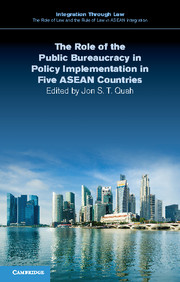Book contents
- Frontmatter
- Contents
- List of tables
- List of contributors
- General editors’ preface
- Preface
- 1 The role of the public bureaucracy in policy implementation in five ASEAN countries: a comparative overview
- 2 Weak central authority and fragmented bureaucracy: a study of policy implementation in Indonesia
- 3 The public bureaucracy's role in policy implementation in Malaysia
- 4 Dysfunctional bureaucracy, corruption and weak rule of law: a case study of policy implementation in the Philippines
- 5 Governance and meritocracy: a study of policy implementation in Singapore
- 6 Vietnam's public bureaucracy and implementation of two ASEAN policies
- 7 Policy implementation in ASEAN and the European Union: the problem of asymmetric compliance
- Executive summary
- Index
- References
1 - The role of the public bureaucracy in policy implementation in five ASEAN countries: a comparative overview
Published online by Cambridge University Press: 05 February 2016
- Frontmatter
- Contents
- List of tables
- List of contributors
- General editors’ preface
- Preface
- 1 The role of the public bureaucracy in policy implementation in five ASEAN countries: a comparative overview
- 2 Weak central authority and fragmented bureaucracy: a study of policy implementation in Indonesia
- 3 The public bureaucracy's role in policy implementation in Malaysia
- 4 Dysfunctional bureaucracy, corruption and weak rule of law: a case study of policy implementation in the Philippines
- 5 Governance and meritocracy: a study of policy implementation in Singapore
- 6 Vietnam's public bureaucracy and implementation of two ASEAN policies
- 7 Policy implementation in ASEAN and the European Union: the problem of asymmetric compliance
- Executive summary
- Index
- References
Summary
Introduction
The Parable of the Owl and the Centipede
In the forest there lived a centipede who developed foot problems, and for a centipede that means a lot of pain. He asked the other animals what he could do about it, and no one had any suggestion except that he ask the Wise Old Owl.
So he went to the Wise Old Owl. ‘Wise Old Owl, Wise Old Owl’, he said. ‘Tell me what I can do about my aching feet.’ The Wise Old Owl considered the problem and said, ‘Go back to your home and turn into a fish.’ Since a fish has no feet, that seemed like good advice, so the centipede went home and tried it out. But, no matter how hard he tried, he couldn't turn into a fish. He asked the other animals how to do it and none of them knew.
Again he limped back to the Wise Old Owl. ‘Wise Old Owl, Wise Old Owl’, he said. ‘I have tried very hard, every way I can think of, to turn into a fish, but I can't. Please, Wise Old Owl, Wise Old Owl, tell me how to do it.’
The Wise Old Owl looked annoyed. ‘You don't understand my situation. I don't know how to do anything like that; I just make policy.’
(Steve Sachs, Attorney General of Maryland, quoted in Young 1983: 39)This parable captures accurately the relative ease of formulating a policy on the one hand, as well as the difficulties encountered in policy implementation on the other hand. In their analysis of policy implementation in the Third World, Bertsch, Clark and Wood (1986: 472) observe that many governments ‘operate under administrative, economic, and political constraints that virtually guarantee failure at the point where the policy is applied to the society’. Caiden (1976: 142–64) describes implementation as the ‘Achilles’ heel’ of administrative reform and identifies twelve reasons for the failure of policy implementation in the developing countries. Perhaps the most comprehensive analysis of the difficulties encountered in implementing policies is provided by Chase (1979: 386–435) who has identified forty-four obstacles to the implementation of human services programmes. In their pioneering book, Implementation, Pressman and Wildavsky (1973: xiii) contend that ‘implementation, under the best of circumstances, is exceedingly difficult’.
- Type
- Chapter
- Information
- Publisher: Cambridge University PressPrint publication year: 2016
References
- 1
- Cited by

